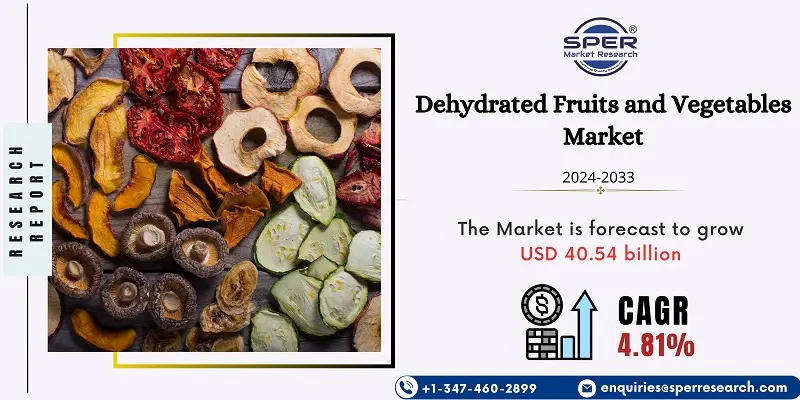
Dehydrated Fruits and Vegetables Market Trends, Share, Demand, Revenue and Future Outlook
Dehydrated Fruits and Vegetables Market Growth, Size, Trends Analysis- By Product Type, By Product, By Distribution Channel- Regional Outlook, Competitive Strategies and Segment Forecast to 2033
| Published: Nov-2024 | Report ID: FOOD24119 | Pages: 1 - 225 | Formats*: |
| Category : Food & Beverages | |||
- June 2024; A new technique that makes noodles with less fat and salt was given USD 29.1 million by Nestle.
- March 2024; A new carefully prepared freeze-dried miso soup was introduced by Amano Foods. There are several varieties of the product that include vegetables, spices, and seasonings.


| Report Metric | Details |
| Market size available for years | 2020-2033 |
| Base year considered | 2023 |
| Forecast period | 2024-2033 |
| Segments covered | By Product Type, By Product, By Distribution Channel |
| Regions covered | North America, Asia-Pacific, Latin America, Middle East & Africa, and Europe. |
| Companies Covered | European Freeze Dry, Ajinomoto Co. Inc, Nutristore Canada, Augason Farms, Nestlé SA, Asahi Group Holding Ltd, Harmony House Foods Inc., LYOFOOD Sp. z.o.o., Thrive Life LLC, OFD Foods LLC. |
- Dehydrated fruit and vegetable manufacturers
- Food and beverage companies
- Retailers and distributors of processed foods
- Supermarkets and hypermarkets
- Health-conscious consumers
- Hotels, restaurants, and catering (HORECA) businesses
- Food ingredient suppliers
- Exporters and importers of dried foods
- Government and regulatory bodies
| By Product Type: | |
| By Product: | |
| By Distribution Channel: | |
| By Region: |
- Global Dehydrated Fruits and Vegetables Market Size (FY’2024-FY’2033)
- Overview of Global Dehydrated Fruits and Vegetables Market
- Segmentation of Global Dehydrated Fruits and Vegetables Market by Product Type (Spray-Dried, Freeze-Dried, Vacuum-Dried, Sun-Dried, and Others)
- Segmentation of Global Dehydrated Fruits and Vegetables Market by Product (Dairy Products, Fruits and Vegetables, Meat and Seafood, Instant Coffee, Dehydrated Prepared Meals, Spices and Herbs, and Others)
- Segmentation of Global Dehydrated Fruits and Vegetables Market by Distribution Channel (Hypermarket/Supermarket, Convenience Stores, Online Retail Stores, and Other Channels)
- Statistical Snap of Global Dehydrated Fruits and Vegetables Market
- Expansion Analysis of Global Dehydrated Fruits and Vegetables Market
- Problems and Obstacles in Global Dehydrated Fruits and Vegetables Market
- Competitive Landscape in the Global Dehydrated Fruits and Vegetables Market
- Impact of COVID-19 and Global Demonetization on Dehydrated Fruits and Vegetables Market
- Details on Current Investment in Global Dehydrated Fruits and Vegetables Market
- Competitive Analysis of Global Dehydrated Fruits and Vegetables Market
- Prominent Players in the Global Dehydrated Fruits and Vegetables Market
- SWOT Analysis of Global Dehydrated Fruits and Vegetables Market
- Global Dehydrated Fruits and Vegetables Market Future Outlook and Projections (FY’2024-FY’2033)
- Recommendations from Analyst
1.1. Scope of the report1.2. Market segment analysis
2.1. Research data source
2.1.1. Secondary Data2.1.2. Primary Data2.1.3. SPER’s internal database2.1.4. Premium insight from KOL’s
2.2. Market size estimation
2.2.1. Top-down and Bottom-up approach
2.3. Data triangulation
4.1. Driver, Restraint, Opportunity, and Challenges analysis
4.1.1. Drivers4.1.2. Restraints4.1.3. Opportunities4.1.4. Challenges
4.2. COVID-19 Impacts of the Global Dehydrated Fruits and Vegetables Market
5.1. SWOT Analysis
5.1.1. Strengths5.1.2. Weaknesses5.1.3. Opportunities5.1.4. Threats
5.2. PESTEL Analysis
5.2.1. Political Landscape5.2.2. Economic Landscape5.2.3. Social Landscape5.2.4. Technological Landscape5.2.5. Environmental Landscape5.2.6. Legal Landscape
5.3. PORTER’s Five Forces
5.3.1. Bargaining power of suppliers5.3.2. Bargaining power of buyers5.3.3. Threat of Substitute5.3.4. Threat of new entrant5.3.5. Competitive rivalry
5.4. Heat Map Analysis
6.1. Global Dehydrated Fruits and Vegetables Market Manufacturing Base Distribution, Sales Area, Product Type6.2. Mergers & Acquisitions, Partnerships, Product Launch, and Collaboration in Global Dehydrated Fruits and Vegetables Market
7.1. Global Dehydrated Fruits and Vegetables Market Size, Share and Forecast, By Product Type, 2020-20267.2. Global Dehydrated Fruits and Vegetables Market Size, Share and Forecast, By Product Type, 2027-20337.3. Spray-Dried7.4. Freeze-Dried7.5. Vacuum-Dried7.6. Sun-Dried7.7. Others
8.1. Global Dehydrated Fruits and Vegetables Market Size, Share and Forecast, By Product, 2020-20268.2. Global Dehydrated Fruits and Vegetables Market Size, Share and Forecast, By Product, 2027-20338.3. Dairy Products8.4. Fruits and Vegetables8.5. Meat and Seafood8.6. Instant Coffee8.7. Dehydrated Prepared Meals8.8. Spices and Herbs8.9. Others
9.1. Global Dehydrated Fruits and Vegetables Market Size, Share and Forecast, By Distribution Channel, 2020-20269.2. Global Dehydrated Fruits and Vegetables Market Size, Share and Forecast, By Distribution Channel, 2027-20339.3. Hypermarket/Supermarket9.4. Convenience Stores9.5. Online Retail Stores9.6. Other Channels
10.1. Global Dehydrated Fruits and Vegetables Market Size and Market Share
11.1. Global Dehydrated Fruits and Vegetables Market Size and Market Share By Region (2020-2026)11.2. Global Dehydrated Fruits and Vegetables Market Size and Market Share By Region (2027-2033)11.3. Asia-Pacific
11.3.1. Australia11.3.2. China11.3.3. India11.3.4. Japan11.3.5. South Korea11.3.6. Rest of Asia-Pacific
11.4. Europe
11.4.1. France11.4.2. Germany11.4.3. Italy11.4.4. Spain11.4.5. United Kingdom11.4.6. Rest of Europe
11.5. Middle East and Africa
11.5.1. Kingdom of Saudi Arabia11.5.2. United Arab Emirates11.5.3. Qatar11.5.4. South Africa11.5.5. Egypt11.5.6. Morocco11.5.7. Nigeria11.5.8. Rest of Middle-East and Africa
11.6. North America
11.6.1. Canada11.6.2. Mexico11.6.3. United States
11.7. Latin America
11.7.1. Argentina11.7.2. Brazil11.7.3. Rest of Latin America
12.1. European Freeze Dry
12.1.1. Company details12.1.2. Financial outlook12.1.3. Product summary12.1.4. Recent developments
12.2. Ajinomoto Co. Inc
12.2.1. Company details12.2.2. Financial outlook12.2.3. Product summary12.2.4. Recent developments
12.3. Nutristore Canada
12.3.1. Company details12.3.2. Financial outlook12.3.3. Product summary12.3.4. Recent developments
12.4. Augason Farms
12.4.1. Company details12.4.2. Financial outlook12.4.3. Product summary12.4.4. Recent developments
12.5. Nestlé SA
12.5.1. Company details12.5.2. Financial outlook12.5.3. Product summary12.5.4. Recent developments
12.6. Harmony House Foods Inc
12.6.1. Company details12.6.2. Financial outlook12.6.3. Product summary12.6.4. Recent developments
12.7. LYOFOOD Sp. z.o.o
12.7.1. Company details12.7.2. Financial outlook12.7.3. Product summary12.7.4. Recent developments
12.8. Thrive Life LLC
12.8.1. Company details12.8.2. Financial outlook12.8.3. Product summary12.8.4. Recent developments
12.9. OFD Foods LLC
12.9.1. Company details12.9.2. Financial outlook12.9.3. Product summary12.9.4. Recent developments
12.10. Asahi Group Holding Ltd
12.10.1. Company details12.10.2. Financial outlook12.10.3. Product summary12.10.4. Recent developments
12.11. Others
SPER Market Research’s methodology uses great emphasis on primary research to ensure that the market intelligence insights are up to date, reliable and accurate. Primary interviews are done with players involved in each phase of a supply chain to analyze the market forecasting. The secondary research method is used to help you fully understand how the future markets and the spending patterns look likes.
The report is based on in-depth qualitative and quantitative analysis of the Product Market. The quantitative analysis involves the application of various projection and sampling techniques. The qualitative analysis involves primary interviews, surveys, and vendor briefings. The data gathered as a result of these processes are validated through experts opinion. Our research methodology entails an ideal mixture of primary and secondary initiatives.



Frequently Asked Questions About This Report
PLACE AN ORDER
Year End Discount
Sample Report
Pre-Purchase Inquiry
NEED CUSTOMIZATION?
Request CustomizationCALL OR EMAIL US
100% Secure Payment






Related Reports
Our Global Clients
Our data-driven insights have influenced the strategy of 200+ reputed companies across the globe.




















